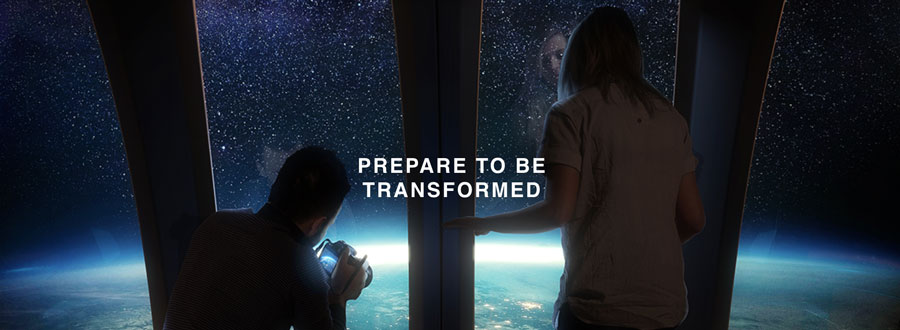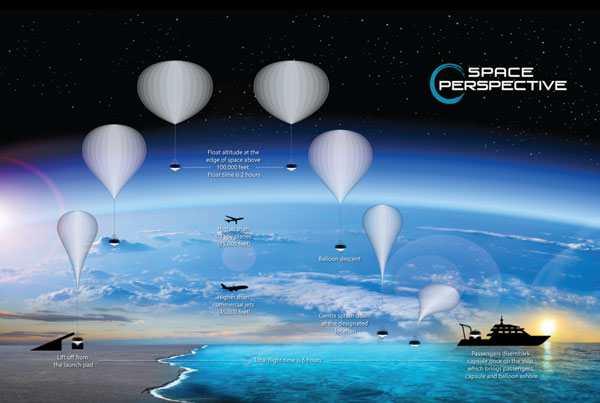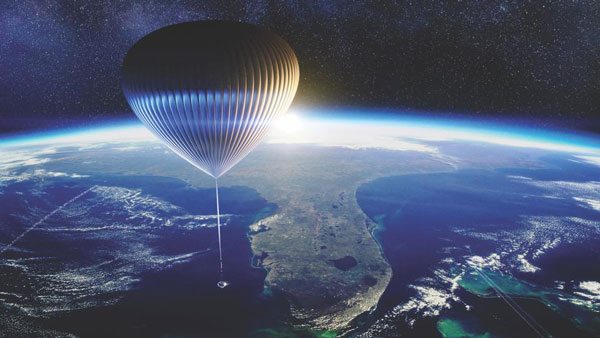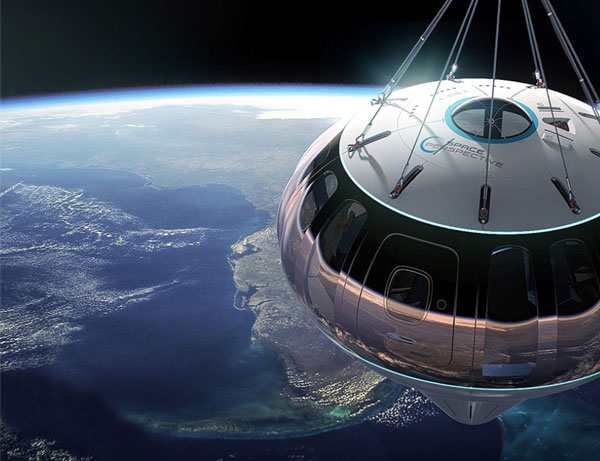The Space Perspective
Throughout the sixty year history of human spaceflight, the characteristics necessary to become an astronaut have seemed obvious. To make it to space, you have to be brave. You have to have the ‘Right Stuff’. You have to be very fit, and to be prepared to endure rigorous training. And if you are successful, you will experience extreme ‘g’ forces, noise and vibration caused by the explosive power of a rocket launch. Until now.
How about the prospect of a nice relaxing trip where you can enjoy a drink at the bar with your fellow passengers while you enjoy the view? A journey which requires no spacesuit – just your everyday clothes will do… although maybe you could dress a little for the occasion with a comfortable lounge suit or cocktail dress. There will be no need for high intensity training – just a brief familiarisation video and some safety guidance will be enough. As for fitness: well, if you’re healthy enough for a scheduled airline flight, you’re good to go. And if you’re concerned about the ‘g’ forces and vibration messing with your stylish outfit, worry no more – your trip to space will all be accomplished at less speed than you would experience on a slow bike ride through the countryside.
If this all sounds like a hopelessly unrealistic futuristic fantasy you would have been right. Until now. Today, there is the Space Perspective. If things go according to plan, you will be able to enjoy just such a journey – maybe as early as 2024. OK, you will still have to have lots of money, but perhaps not as much as you may think. Prices are expected to be around half what you’ll have to pay for a ticket with Richard Branson’s Virgin Galactic.
So what kind of revolutionary technology is involved in this amazing new spaceship? A carbon fibre Space Elevator? Some kind of ion beam accelerator? A Star Trek style teleportation device? Nope. None of these will be required. You will be going to space in a balloon.

The Space Perspective – How will it Work?
The basic idea is that passengers will be gently lifted into space via a pressurised capsule called Neptune. This will be suspended from a giant hydrogen filled balloon. The balloon and capsule combination will reach an altitude of around 100,000 feet. This is about 20 miles, or 30 km above the Earth’s surface – beyond the commonly accepted boundary of space. It will then cruise at that height for around two hours, enabling its passengers to enjoy the view at leisure (and enjoy the contents of the on board bar), before taking a further couple of hours to gently descend to Earth. The capsule will then splashdown in the ocean before being retrieved by a support ship.
Let’s look into these proposals in a little more detail.
The Space Perspective Flight
Unlike many of the proposed conventional rocket powered trips to space, this journey will be a relatively leisurely affair, lasting around six hours. The initial launch site will be located at the former Space Shuttle landing site at NASA’s Kennedy Space Centre (KSC) in Florida. The Space Perspective company has already signed a support agreement with NASA and leased facilities at the KSC. There are also plans for a new Cecil Spaceport in Jacksonville, Florida.
After the balloon is released, passengers will experience a gradual rise, at a speed of around 12 mph – no more than the pace of a typical bicycle ride. At that pace, it will take around two hours to reach the balloon’s cruising height of 100,000 feet. This will allow plenty of time to take in the gradually changing view, with its varying perspectives of the Earth beneath.
The balloon will remain at that altitude for around two hours, where passengers can admire the blue orb beneath them; the curvature of the Earth; the thin blue line of our planet’s atmosphere and the blackness of space above. At this height, the capsule will be above 99% of the Earth’s atmosphere.
Passengers will be able to communicate with friends and family on the ground and post footage. There will be Wi-Fi on board, so Live Facebook streams will be possible, and the Instagram opportunities will be spectacular.
Flights are planned to take off in the small hours of the morning, so it’s best to be an early riser. This schedule is not just to upset sleep patterns, but to take maximum advantage of atmospheric and daytime / night time conditions. By taking off before dawn, passengers can enjoy the blackness of space and the spectacular starscape, before the sun rises over the horizon to reveal the blue Earth beneath.
After a couple of hours in space, the descent will begin. This will also be a gradual affair of around 12 mph, taking about another 2 hours until splashdown. Stratospheric winds are seasonal, so landing sites can vary. If take off is from the KSC in Florida, in winter the capsule will land around 200 miles downwind in the North Atlantic, east of the launch site. In summer, landings will be in the Gulf of Mexico, about 30 miles offshore, west of the launch area. The capsule will then be retrieved from the ocean by a support ship, much like the Apollo astronauts were collected after their lunar missions in the 1960s and 70s.
It should also be pointed out that the balloon launch equipment is mobile, and with splashdown areas also being very flexible, launches will in future be able to take place almost anywhere there is enough large open space. This could include any conventional airfield. Long term plans are in place for launch sites in Europe and Asia. Alaska is another keenly anticipated location for launches, as this will provide the mouth-watering prospect of viewing the Northern Lights (aurora borealis) from space.

The Space Perspective Balloon
The balloon used to transport the Neptune capsule and its passengers will be enormous. At launch, it will be 600ft tall, but as it rises through the atmosphere it will become even larger. As the atmospheric pressure of the surrounding air decreases with altitude, the balloon will expand massively, so that when it is cruising at its maximum altitude it will be the size of a football stadium.
The gas used to fill the balloon will be hydrogen. The original plan to use helium was abandoned. This is because helium is a scarce resource on Earth, and is required for its many scientific and medical uses. Filling a massive balloon with this valuable gas would therefore have been unethical and impractically expensive in any case.
Each balloon will only be used once, although the materials used in its manufacture will be recycled. It would be far more expensive to attempt to refurbish the massive envelope than to simply construct a new one. If this sounds a little wasteful, remember that every flight is zero emission, so it is environmentally friendly when compared with the exhaust gases from the kerosene or methane fuel used for conventional rocket flights.

The Space Perspective Capsule
The Neptune capsule will be circular in shape, measuring about 5m (about 16 feet) in diameter. This will, provide close to 20m2 (180 cubic feet) of volume to move around in. Each capsule will be able to carry eight passengers, plus the pilot.
There will be nine seats, placed around the perimeter of the capsule facing outwards, with space in the centre to stand and admire the view. There will be ceiling to floor curved windows, offering a 360 degree view of space and to the blue orb below. There will also be a small dome at the top of the capsule offering a totally unobstructed view.
At the centre of the capsule will be a bar, with a toilet below. This will provide a possibly unmissable sponsorship opportunity for Carlsberg, as it will be the loo with “probably the best view in the universe”.
The capsule will be pressurised to a similar level to that which passengers experience on a typical long haul airline flight. Cabin pressure is therefore planned to be broadly equivalent to that found at about 7,000 feet in altitude.
The capsule will be re-usable, with a turnaround time of around a week between flights.

Safety Aboard The Space Perspective Flights
Of course, no form of space travel can ever be 100% risk free, but there are so many back-up mechanisms on this spacecraft that it really seems as if it is as safe as it could possibly be.
The on board pilot will be responsible for the flight. But there will also be a co-pilot on the ground, who will be able to take control of the balloon if the pilot is incapacitated or unavailable for any reason (illness, taking care of a passenger emergency, going to the loo…) Even if the connection to the co-pilot is lost for any reason, the on-board software will recognise this and take over, a bit like an aircraft auto-pilot system. This will even have the ability to land the balloon if necessary.
As for aerial buoyancy, the balloon is so large that catastrophic failure is unlikely. There will be so much residual gas to provide lift that the balloon cannot ‘crash’ to Earth. In any case, the capsule will have back up parachutes which can be deployed in an unexpected emergency. What is more, these are no ordinary parachutes. They can be opened and deployed even if capsule is not falling, such as if required to rapidly return the capsule to Earth at take-off.
The use of the highly flammable gas hydrogen could also be a potential issue. On the other hand, it may be considered less risky to be suspended from a balloon full of hydrogen with a parachute system at the ready, than it would be to be sitting on top of a rocket full of thousands of gallons of highly volatile kerosene. In any case, the utmost precautions are taken to ensure that the hydrogen in the balloon cannot mix with the outside air. Careful manufacture and constant monitoring also prevent the possibility of any dangerous static charges or electrical sparks.
Scientific and Other Plans
Although the primary goal of The Space Perspective company is to carry commercial passengers into space, the potential of the Neptune capsule offers far more flexibility than a conventional rocket launch.
The balloon and capsule will cruise in a part of the upper stratosphere which is relatively inaccessible. Commercial airlines and other aircraft generally fly up to an altitude of around 45,000 feet. Spy planes routinely reach 75,000 feet. The International Space Station (ISS) on the other hand, is at Low Earth Orbit (LEO), which is about 250 miles above the Earth.
100,000 feet is therefore too high, with too little air for conventional aircraft, and too low for orbit. It is therefore difficult to get to and hard to stay there for a significant amount of time.
The Space Perspective balloon and capsule combination will offer a practical way to study and observe this comparatively unexplored yet crucial part of the atmosphere – the very boundary between Earth and space. Above 99% of the Earth’s atmosphere, potential on board scientific observations may provide crucial insights into weather patterns and climate change. Research into other aspects of science, such as astrophysics, astrobiology and solar patterns will also be possible.
In addition, the regular flights will provide an easy way to replicate and compare results over time – a factor which is very important in scientific experimentation and observation. This opportunity to make repeat visits is simply impractical for conventional rocket launches because of the weight and capacity restrictions.
The capacity of the Neptune capsule offers wider opportunities too. The scope for live streamed lessons and lectures offers a useful educational link up with the scientific programmes, but there are artistic potentials too. Live streamed concerts from space would be awe inspiring and the opportunity for other artists such as poets and writers to make the trip could do much to raise environmental awareness within the Earth-bound population. In particular, the founders of the company believe that the prospect of influential people like world leaders, artists and musicians getting this opportunity could lead a change of direction back on Earth as more opinion formers and policy makers experience the life-changing view.
… Now you may well be thinking that this all seems a bit too good to be true. Isn’t this all a bit ‘pie in the sky’ rather than ‘passengers in space’? Well, if we take a look at the people behind The Space Perspective company, maybe this will reassure you that this outfit is a serious contender and can deliver on its promises…
The History of The Space Perspective
The mission of the company is focused on the belief that everybody should have the opportunity to see the Earth from the edge of space. The two co-founders and joint CEOs of The Space Perspective have a wealth of relevant experience to help them make this dream a reality.
Both Jayne Pointer and Taber MacCullum were part of the crew of Biosphere 2 which ran for two years from September 1991. The idea behind this experiment was to demonstrate the viability of closed ecological systems, in order to support and maintain human life in outer space.
The seven biomes covered an area of just over three acres. These were situated in the Arizona desert and were completely sealed off from the outside environment. The plants and resources inside were intended to provide all the nutrients, food and oxygen for the eight strong crew, without any additional outside support. Although not totally successful, the experiment set new world records for closed ecological systems and for remarkable efficiencies in agricultural output. Failures were more down to financial and political issues outside the Biosphere than problems within.
Subsequently, in 2014, Taber MacCullum was part of the Paragon Space Development team which enabled Alan Eustace to break the world record for the highest altitude free fall jump. The jump was made from a balloon at a height of close to 136,000 feet, or over 25 miles (41km) up in the stratosphere. The free fall descent lasted for four and a half minutes and Eustace reached a top speed of around 820 mph, creating a sonic boom which was heard on the ground. It took an additional nine minutes under parachutes for Eustace to finally reach the ground.
None of this is anything like what passengers on board The Space Perspective’s Neptune capsule can be expected to undergo, but at least it shows the wealth of experience and expertise behind the company. This pair are serious about their idea and it does seem like a genuine prospect that their proposed balloon will be able to carry people to the edge of space within the next few years.
Timetable and Price of Space Perspective Flights
The timetable the company have set for themselves is ambitious, but realistic. The first un-crewed test flights are planned for 2021, with a first human test flight slated for late 2023 or early 2024. The first commercial passenger carrying flights are planned for the end of 2024. And if that all seems a bit soon, remember that they have done it before – reaching even higher on their successful world record free fall attempt in 2014.
The first ticket sales are expected to take place in 2021, and potential passengers can express an interest by registering on The Space Perspective website. But before you do that, I guess it would be helpful to know how much it’s going to cost…
Well, the final ticket price has yet to be set, but it is estimated to be around $125,000 per passenger. With Virgin Galactic expected to charge around twice that for a trip on SpaceShipTwo, that sounds very competitive indeed.
The initial plan, once multiple capsules are available, is to launch at least 100 flights per year from Kennedy Space Centre alone, with additional launch sites following shortly after.
Space Perspective Flights Offers You Choice
The Space Perspective’s revolutionary plans are totally re-imagining what space travel can be. At the time of writing, fewer than 600 people have been in space. This represents an average of less than ten per year. But with the company’s new balloon, there will be the prospect of sending more than this number of people to space every year – and that’s with just one capsule. And with multiple capsules in prospect, even the sky is no limit.
Their balloon and capsule combination also greatly adds to the choice of experience available. Fancy the adrenaline rush of the high ‘g’ forces and weightlessness of a rocket flight? It looks like you may want to choose Virgin Galactic or SpaceX. You get to wear a space suit and you will certainly get the full astronaut experience. On the other hand, it won’t necessarily last that long as you will be travelling at great speed, both up and down again.
Or, you may prefer the more leisurely experience of floating silently upward, enjoying the view as you go. It’ll take the best part of a day, so you can soak up the changing vista as you enjoy your favourite tipple and chat to your fellow voyagers. Oh, and not forgetting one further advantage for choosing a leisurely balloon over a powerful rocket… it’s half the price.
What About Weightlessness Onboard a Space Perspective Flight?
Hang on a minute I can hear you saying… How come passengers on this balloon will be standing around at a bar in their smart casual clothes drinking wine and spirits in the blackness of space? Aren’t they supposed to be weightless? Surely they’ll spill their drinks as they float helplessly across the cabin?
Ah, well there is an explanation for this apparent discrepancy. The thing is, the reason why astronauts in orbit around the Earth are apparently weightless is not because they are in space. The Earth’s gravity at the height of Low Earth Orbit (where the International Space Station is, for example) still exerts around 90% of the force it does at the Earth’s surface. In fact, the reason why astronauts on the ISS are floating around is because they are in ‘free fall’.
Basically, the space station is flying around the Earth very fast. Its horizontal speed is so great that instead of falling to Earth, it falls around it, missing the Earth’s surface. The ISS and its astronaut occupants are therefore in ‘free fall’ as they orbit the Earth.
As for conventional rocket powered space flights like those proposed by Virgin Galactic, SpaceX and Blue Origin, the reason why these passengers will experience weightlessness is because when they return to Earth, they will be also be experiencing free fall. But on The Space Perspective balloon, passengers won’t ever be in free fall. Their passengers will float up, and float down again, safely cocooned in their pressurised capsule, supported by the hydrogen filled balloon.
Which is a good job – all that spilt alcohol would make quite a mess.
